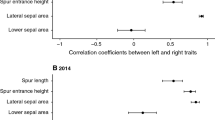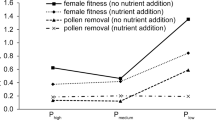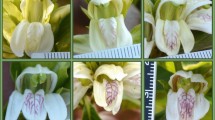Abstract
The maintenance of flower size variation within populations might be explained by conflicting selection pressures on floral traits that may involve biological agents, such as mutualists and antagonists, and allocation costs associated with floral display. The annual species Madia sativa (Asteraceae) exhibits ample variation in the number of ray florets in natural populations. This field study aimed at evaluating the costs and benefits associated with floral traits in M. sativa. In particular, we addressed two main questions: (1) Is the number of ray florets positively associated with pollinator visitation rate? (2) Is there a fitness cost of ray floret maintenance when pollinators are absent? We detected one benefit of conspicuous ray capitula: a strong preference by insect pollinators. We also confirmed the occurrence of costs: when pollinators were excluded conspicuous ray capitula had a reduced reproductive assurance via autogamous selfing, and there were trade-offs between the number of ray florets and seed mass and seed germination. Results suggest that the maintenance of within-population variation in the number of ray florets in M. sativa is explained, at least in part, by the balance between costs and benefits associated with this floral trait.
Similar content being viewed by others
References
Andersson S (1991) Floral display and pollination success in Achillea ptarmica (Asteraceae). Holarc Ecol 14:186–191
Andersson S (1996) Floral display and pollination success in Senecio jacobaea (Asteraceae): interactive effects of head and corymbs size. Am J Bot 83:71–75
Andersson S (1997) Genetic constraints on phenotypic evolution in Nigella (Ranunculaceae). Biol J Linn Soc 62:519–532
Andersson S (1999) The cost of floral attractants in Achillea ptarmica (Asteraceae): evidence from a ray removal experiment. Plant Biol 1:569–572
Andersson S (2000) The cost of flowers in Nigella degenii inferred from flower and perianth removal experiments. Int J Plant Sci 161:903–908
Anderssson S (2001) Fitness consequences of floral variation in Senecio jacobaea (Asteraceae): evidence from segregating hybrid population and a resource manipulation experiment. Biol J Linn Soc 74:17–24
Anderssson S (2005) Floral costs in Nigella sativa (Ranunculaceae) compensatory responses to perianth removal. Am J Bot 92:279–283
Arroyo MTK, Uslar P (1993) Breeding systems in a temperate Mediterranean-type climate montanae sclerophyllous forest in central Chile. Bot J Linn Soc 111:83–102
Arroyo MTK, Armesto JJ, Villagrán C (1981) Plant phenological patterns in the high Andean Cordillera of central Chile. J Ecol 69:205–223
Ashman TL, Schoen DJ (1996) Floral longevity: fitness consequences and resource costs. In: Lloyd DG, Barrett SCH (eds) Floral biology. Chapman and Hall, New York, pp 112–139
Ashman TL, Schoen DJ (1997) The cost of floral longevity in Clarkia temblorensis: an experimental investigation. Evol Ecol 11:289–300
Brody AK (1992) Oviposition choices by a pre-dispersal seed predator (Hylema sp.). I. Correspondence with hummingbird pollinators, and the role of plant size, density and floral morphology. Oecologia 91:56–62
Campbell DR (1991) Effects of floral traits on sequential components of fitness in Ipomopsis aggregata. Am J Bot 137:713–737
Cariveau D, Irwin RE, Brody AK et al (2004) Direct and indirect effects of pollinators and seed predators to selection on plant and floral traits. Oikos 104:15–26
Charlesworth D, Charlesworth B (1987) Inbreeding depression and its evolutionary consequences. Annu Rev Ecol Syst 18:237–268
Conner JK, Rush S (1996) Effects of flower size and number on pollinator visitation to wild radish, Raphanus raphanistrum. Oecologia 105:509–516
Cruzan MB, Neal PR, Willson MF (1988) Floral display in Phyla incisa: consequences for male and female reproductive success. Evolution 42:505–515
Darwin C (1876) The effect of cross and self fertilization in the vegetable kingdom: Murray, London, UK
Di Castri F, Hajek ER (1976) Bioclimatología de Chile. Editorial Universidad Católica de Chile. Santiago, Chile
Eckhart VM (1991) The effects of floral display on pollinator visitation vary among population of Phacelia linearis (Hydrophyllaceae). Evol Ecol 5:370–384.
Elle E, Carney R (2003) Reproductive assurance varies with flower size in Collinsia parviflora (Scrophularaceae). Am J Bot 90:888–896
Fenner M, Creswell JE, Hurley RA et al. (2002) Relationship between capitulum size and pre-dispersal seed predation by insect larvae in common Asteraceae. Oecologia 130:72–77
Galen C (1989) Measuring pollinator mediated-selection on morphometric floral traits: bumblebees and the alpine sky pilot, Pollemonium viscosum. Evolution 43:882–890
Galen C (1999) Why do flowers vary? The functional ecology of variation in flower size and form within natural plant populations. Bioscience 49:631–640
Galen C, Newport MEA (1987) Bumble bee behavior and selection on flower size in the sky pilot, Polemonium viscosum. Oecologia 74:20–23
Galen C, Sherry RA, Carroll AB (1999) Are flowers physiological sinks or faucets? Costs and correlates of water use by flowers of Polemonium viscosum. Oecologia 118:461–470
Galloway LF, Ciringliano T, Gremski K (2002) The contribution of display size and dichogamy to potential geitonogamy in Campanulla Americana. Int J Plant Sci 163:133–139
Herrera CM (1993) Selection on floral morphology and environmental determinants of fecundity in a hawkmoth-pollinated violet. Ecol Monogr 63:251–275
Hoffman AJ (1998) Flora Silvestre de Chile. Zona Central.4th edn. Ediciones Fundación Claudio Gay, Santiago, Chile. pp 254
Imbert E, Escarré J, Lepart J (1996) Achene dimorphism and among-population variation in Crepis sancta (Asteraceae). Int J Plant Sci 157:309–315
Lack AJ (1982) Competition for pollinators in the ecology of Centaurea scabiosa L. and Centaurea nigra L. III. Insect visits and the number of successful pollinations. New Phytol 91:321–339
Lande R., Arnold SJ (1983) The measurement of selection on correlated characters. Evolution 37:1210–1226
Lande R., Schemske DW (1985) The evolution of the self-fertilization and inbreeding depression in plants. I. Genetic models. Evolution 39:24–40
Mani MS, Saravan JM (1999) Pollination ecology and evolution in Compositae (Asteraceae). Science Publishers Inc, New Hampshire
Mooney HA, Dunn EL (1970) Photosynthetic systems of Mediterranean-climate shrubs and trees of California and Chile. Am Nat 104:447–453
Nielsen RL, Phillipp M., Siegismund HR (2002) Selective advantage of ray florets in Scalesia affinis and S. pedunculata (Asteraceae), two endemic species from the Galápagos. Evol Ecol 16:139–153
Olsen KM (1997) Pollination effectiveness and pollinator importance in a population of Heterotheca subaxillaris (Asteraceae). Oecologia 109:114–121
Rocha OJ (1996) The effects of achene heteromorphism on the dispersal capacity of Bidens pilosa L. Int J Plant Sci 157:316–322.
Schluter D. (1988) Estimating the form of natural selection on a quantitative trait. Evolution 42:849–861
Sierra-Almeida A. (2003) Estrategias de germinación de semillas en especies de alta montaña. Licenciate dissertation, Facultad de Ciencias Naturales, Universidad de Concepción, Chile
Stebbins GL (1970) Adaptive radiation of reproductive characteristics in angiosperms, I: pollination mechanisms. Annu Rev Ecol Syst 1:307–326
Stuessy TF, Spooner DM, Evans KA (1986) Adaptive significance of ray corollas in Helianthus grosseserratus (Compositae). Am Mid Nat 151:191–197
Young HJ, Stanton ML (1990) Influences of floral variation on pollen removal in wild radish. Ecology 71:536–547
Acknowledgements
We thank D. Jara, C. Ossa and E. Soto for their assistance during the field work. This work was funded by Fondecyt Postdoctoral grant 3040036 to WLG.
Author information
Authors and Affiliations
Corresponding author
Rights and permissions
About this article
Cite this article
Celedón-Neghme, C., Gonzáles, W.L. & Gianoli, E. Cost and benefits of attractive floral traits in the annual species Madia sativa (Asteraceae). Evol Ecol 21, 247–257 (2007). https://doi.org/10.1007/s10682-006-9002-6
Received:
Accepted:
Published:
Issue Date:
DOI: https://doi.org/10.1007/s10682-006-9002-6




